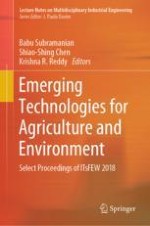This book comprises select proceedings of the International Conference on Emerging Technologies for Farming – Energy & Environment – Water (ITsFEW 2018). The contents are divided into three parts viz., (i) Developments in Farming, (ii) Energy and Environment, and (iii) Water Conservation and Management. The book aims to provide timely solutions, using innovative and emerging technologies, to the global challenges in agriculture, energy, environment, and water management. Some of the topics covered in this book include remote sensing for smart farming, GIS, irrigation engineering, soil science and agronomy, smart grids, renewable energy, energy management systems, energy storage technologies, biological water treatment, industrial waste water treatment, watershed management and sustainability. Given the wide range of topics discussed, the book will be very useful for students, researchers and practitioners interested in agricultural and environmental engineering.
